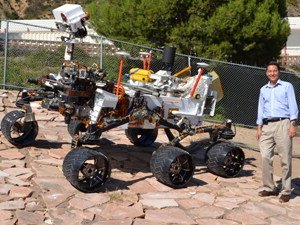A peek into Curiosity

Mars rover has Minnesota ties
When NASA’s Curiosity rover touches down on Mars just after midnight on Aug. 6, 2012 it will be millions of miles away from Earth as it begins its robotic exploration of the planet, but some of the components of the rover have ties close to home.
University of Minnesota aerospace engineering and mechanics alumnus and NASA engineer Steve Lee (Aero ’85) is deeply involved with the Mars Science Laboratory mission, both as the guidance, navigation, and control system manager and as deputy surface phase lead. His work controls the orientation and flight path of the spacecraft, guiding it through different phases of the mission.
Lee helped develop the entry, descent, and landing guidance system, which steers the Mars Science Laboratory to a more precise landing on the surface of Mars culminating in the unique “skycrane” landing technique. He has also worked on the control system of the rover once it is on the surface.
Over the course of a full Martian year (687 Earth days), the Curiosity rover will study rocks, soil, and the geological setting, looking for forms of carbon. The main science goals of the mission are to determine whether Mars could have sustained microbial life, to characterize the climate of Mars, to characterize the geology of Mars, and to prepare for human exploration.
“We’ve only just started answering these questions and exploring whether life is possible on Mars,” Lee said.”
A great beginning
Prior to his work on the Mars Science Laboratory, Lee worked on the Space Shuttle, Space Station, Hubble Space Telescope, and Mars Reconnaissance Orbiter projects. He credits his aerospace education and the University of Minnesota as having a weighty impact on his career.
“It’s great. When working on projects with entry, descent and landing profiles, 80 percent of my education is applicable to my job.” Lee said. “The immediate contributions I was able to make to the field caused me to be noticed early and allow for future career growth.”
Lee has found it rewarding to work with so many aspects of the Mars Science Laboratory mission, with which he has been involved for the past seven years.
Spectacular science
“From a personal standpoint it’s very exciting, putting together a very complicated system and then seeing it very successfully delivered, particularly when the science results will be so spectacular,” Lee said.
The entry, descent, and landing system for the mission are very unique when compared to past missions to Mars. While past missions relied on parachute and airbag landings, the Mars Science Laboratory includes powered descent and sky crane components. As it enters the Martian atmosphere, the spacecraft will be controlled by small rockets to achieve a guided entry. It will initially be slowed by a large parachute, which is then detached and rockets will control the spacecraft’s descent until it is near the surface. The rover will then be lowered from the spacecraft onto the surface of Mars with a sky crane system. The sky crane/rocket system will then veer off and land a safe distance away, so as not to damage the rover. This system represents a huge engineering effort, and must be fully automated. It takes 14 minutes for a signal to travel from Mars to Earth, making any real-time control of the mission impossible.
“In the simulated world, we’ve landed on Mars millions of times,” Lee said in an interview with The New York Times. “I’m actually very comfortable. I’m more comfortable with the impending landing than I was with the launch.”
Curiosity’s ChemCam
Lee is not the only U of M College of Science and Engineering alumnus who has ties to the Mars rover. Physics alumnus Roger Weins (Physics Ph.D. ’88), a scientist at Los Alamos National Laboratory in New Mexico, developed ChemCam aboard Curiosity.
“It’s my baby,” said Wiens, who led a team of 40 American and French scientists in its development.
ChemCam will probe the surface of Mars with a powerful laser pulse that will vaporize pinhead-sized areas of the planet’s surface. The system’s telescope will then peer at the flash of glowing plasma created by the vaporized material and record the colors of light contained within it. A spectrometer will interpret the colors, enabling scientists to determine the composition of the vaporized material.
“ChemCam is designed to look for lighter elements such as carbon, nitrogen, and oxygen, all of which are crucial for life,” said Wiens.
More ties to Mars Science Laboratory
University of Minnesota College of Science and Engineering faculty were also involved with the development of Curiosity. Aerospace engineering and mechanics professor Graham Candler and his team performed numerical simulations of the Mars Science Laboratory (MSL) parachute to understand how it behaves at about Mach 1.5 to 2.5. The problem facing scientists is that at these conditions, the parachute can partially collapse and not produce as much drag as required or expected. The University’s simulations were used to help explain the physical mechanism for this partial collapse process (called area oscillations) and to compare with experimental data.
“I am not sure what the MSL program decided, but I think that they will not deploy the parachute until after Mach 2 where this problem is much less severe,” Candler said.
Aerospace engineering and mechanics professor Ellen Longmire also conducted research related to the Mars rover. Longmire worked with several students performing velocity measurements in the wake of models of the Mars Science Laboratory capsule with and without parachutes attached. The goal was to provide validation data for numerical simulations of these flows in lower Mach number regimes. This work is also aimed at improving capabilities to predict parachute performance when decelerating the vehicle as it re-enters a planetary atmosphere.
For more information about NASA’s Mars Science Laboratory, visit the website at http://nasa.gov/msl.
